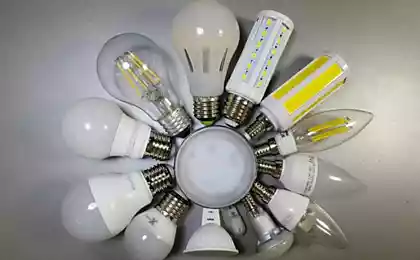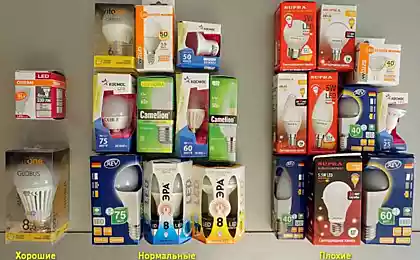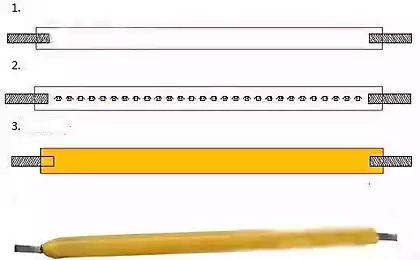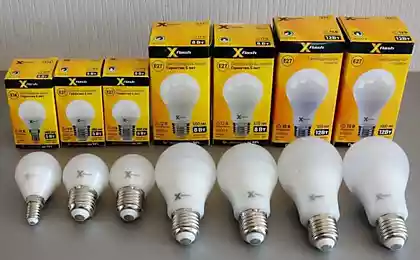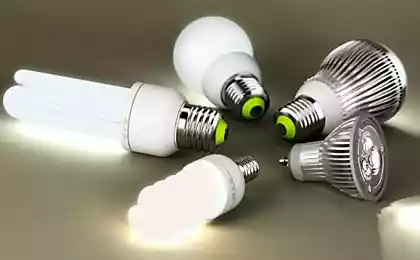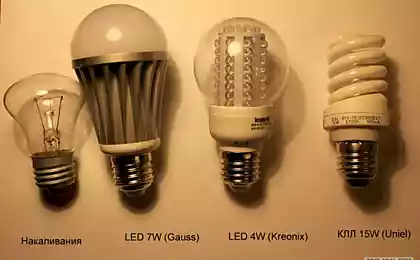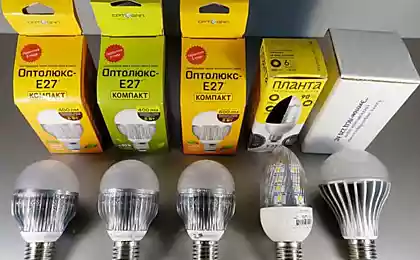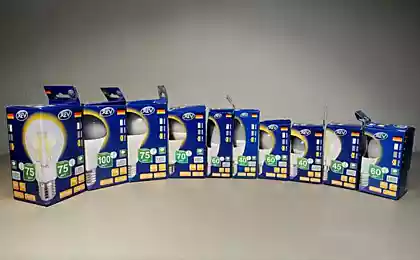755
As manufacturers of LED lamps are deceiving customers
LED lighting is growing popularity. The number of Russian manufacturers of LED lamps close to a hundred. Unfortunately, some of them did not hesitate to deceive the buyer, at the same time discrediting other manufacturers. After all, the buyer fails bought some lamps, then others will be afraid to buy. < Website has recently published a useful article that is present LED lamps and their right to choose. Let razovёm topic and learn how to avoid fakes when buying lamps. Says Alexey Nadёzhin, technical blogger for LED lamps specialist.
Here are two "housekeeper" of the lamp. Judging from the pictures, the buyer should understand that they consume 5 watts, and light as a 60-watt incandescent bulbs.
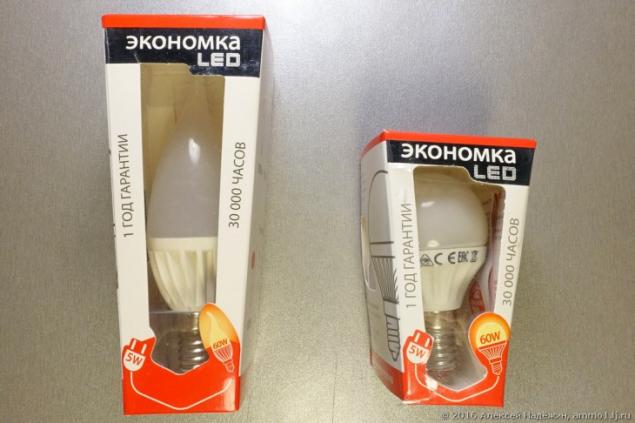
deception already begins to information given on the packaging. Both lamps fine print stated: "Luminous flux: 340 lm»
.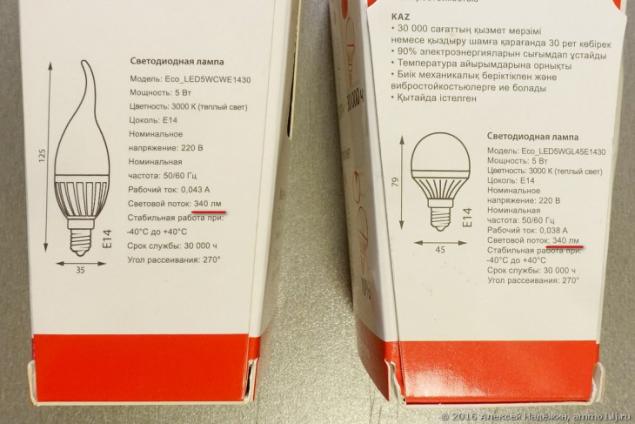
Here are just a 340 lumens is not the equivalent of 60 watts, but only 40. But that's not all hype. Testing both lamps.

Instead of the promised 5 watts in "candles" 4 W, and the "ball" is only 3.9 watts. Luminous flux - 283 and 231 lm. These light bulbs, as a 25-watt incandescent lamp, and the manufacturer promised the equivalent of 60 watts.
Another example - the two "Kosmos" lamps. The manufacturer promises the equivalent of 75 watts for a 7-watt bulb and 60 watts in 5-watt candle.
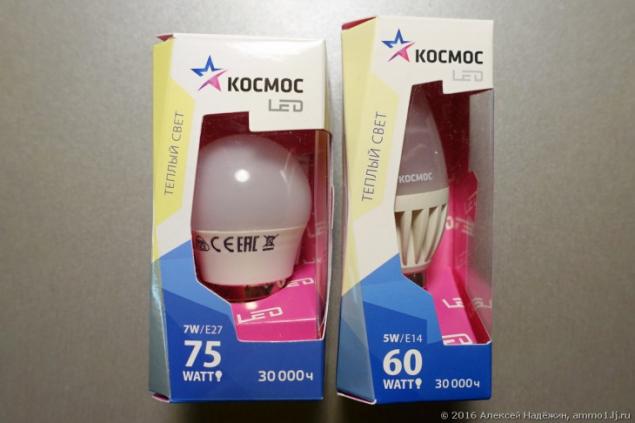
Already-fetched, is not it? Enjoying a very small print on the reverse side of the box.
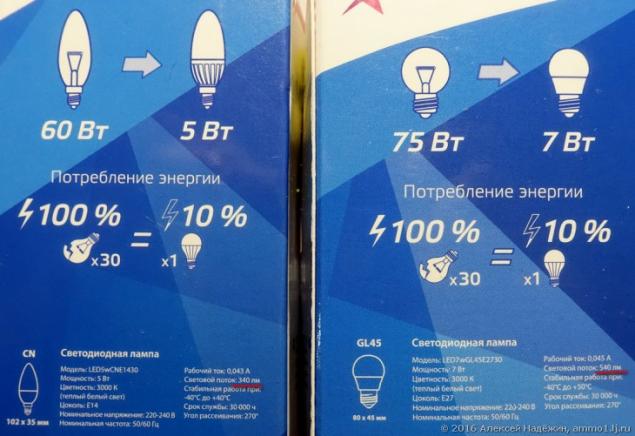
Candle - 340 lm (in fact it is the equivalent of 40 watts), the ball - 540 lumens (the equivalent of 60 watts). Lied already on the box. Measure.
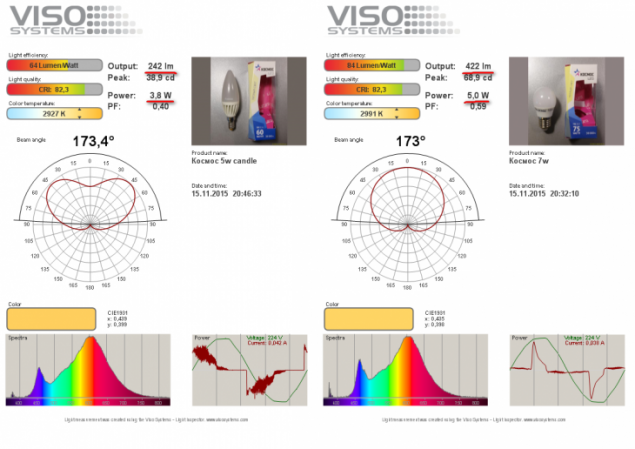
Candle Power 3.8 watts instead of 5 watts. Bulb Power 5W instead of 7 watts. Luminous flux from the candle just 242 lm, at the ball - 422 lm. They promised that the bulbs will shine as 75 watts and 60 watts, but really shine as 45 watts and 25 watts.
Sometimes, manufacturers cheating differently. That Start lamp. On the package indicated 7 watts, the equivalent of 60 watts, 560 lm.
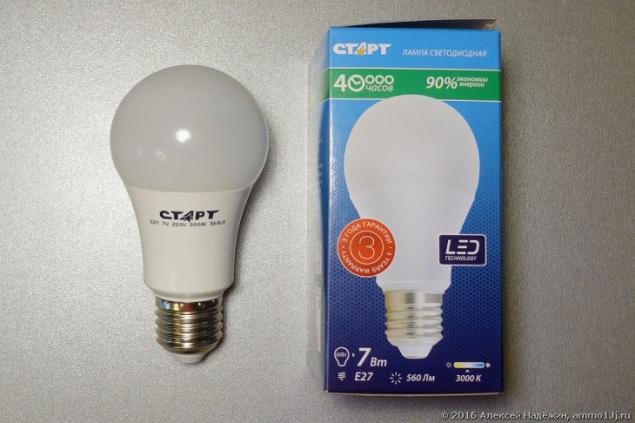
560 lm really corresponds to the equivalent of 60 watts (probably why the manufacturer and put this inscription on the front of the box and wrote it in large print). Measure.
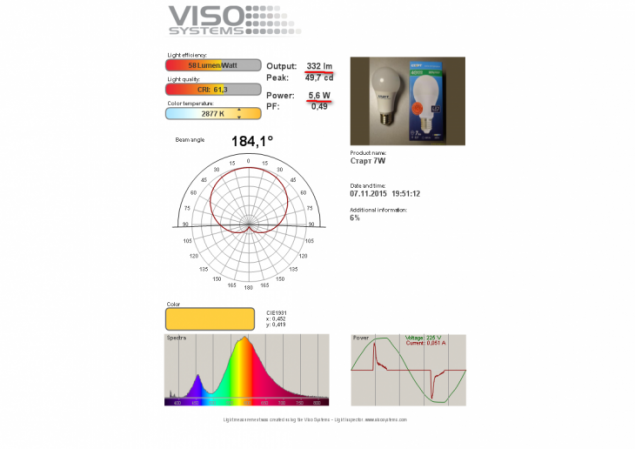
Oops. Instead of only 7 W 5.6 W, and instead only 560 lm 332 lm. The bulb, which is on the assurances of the manufacturer must shine like a 60-watt incandescent bulb, shines as a 40-watt.
Unfortunately, in Russia not controlled LED lamps have been marketed. According to GOST R 54815-2011 LED lamp measured initial luminous flux must be at least 90% of luminous flux. But many guests just spit.
It lies with the power and brightness - that's not all. On sale you can find a large number of tubes with strong visible ripple of light (which can lead to fatigue), as well as lamps with a low color rendering index (CRI), which leads to the fact that the color of objects illuminated by such lamps, look unnatural. < /
I know of only five brands that never lie with the power and luminous flux. And they are not Russian. This Ikea, Osram, Philips, Thomson and Diall (own brand Castorama stores).
Most Russian brands Navigator lamps Nanosvet, Lisma, Gauss, X-Flash have the power and luminous flux, the relevant application, and only some models shine weaker light of these manufacturers than promised. It is easy to explain - Lamp (s Lisma LED strands for the production of lamps) bought in China, and Chinese manufacturers first supply the lamps, the corresponding pre-production samples, and then begin to save money and cheat on their partners and us, the consumers Hardware. test tubes are expensive, tests in laboratories is also not cheap here and it turns out that sometimes the manufacturers know how many actually give their light bulbs, from me.
Before buying LED bulbs, study the results of their testing lamptest.ru. Even if there is no specific model that you want to buy a general opinion about the manufacturer can be on the other models. Often the manufacturer of the lamp is quite good, but you need to enter a "correction for brightness", buying a lamp with a margin of brightness. For example, the same brands housekeeper, Cosmos and Start many lamps are quite decent.
< Do not be fooled!
via geektimes.ru/company/lamptest/blog/271166/
Here are two "housekeeper" of the lamp. Judging from the pictures, the buyer should understand that they consume 5 watts, and light as a 60-watt incandescent bulbs.

deception already begins to information given on the packaging. Both lamps fine print stated: "Luminous flux: 340 lm»
.

Here are just a 340 lumens is not the equivalent of 60 watts, but only 40. But that's not all hype. Testing both lamps.

Instead of the promised 5 watts in "candles" 4 W, and the "ball" is only 3.9 watts. Luminous flux - 283 and 231 lm. These light bulbs, as a 25-watt incandescent lamp, and the manufacturer promised the equivalent of 60 watts.
Another example - the two "Kosmos" lamps. The manufacturer promises the equivalent of 75 watts for a 7-watt bulb and 60 watts in 5-watt candle.

Already-fetched, is not it? Enjoying a very small print on the reverse side of the box.

Candle - 340 lm (in fact it is the equivalent of 40 watts), the ball - 540 lumens (the equivalent of 60 watts). Lied already on the box. Measure.

Candle Power 3.8 watts instead of 5 watts. Bulb Power 5W instead of 7 watts. Luminous flux from the candle just 242 lm, at the ball - 422 lm. They promised that the bulbs will shine as 75 watts and 60 watts, but really shine as 45 watts and 25 watts.
Sometimes, manufacturers cheating differently. That Start lamp. On the package indicated 7 watts, the equivalent of 60 watts, 560 lm.

560 lm really corresponds to the equivalent of 60 watts (probably why the manufacturer and put this inscription on the front of the box and wrote it in large print). Measure.

Oops. Instead of only 7 W 5.6 W, and instead only 560 lm 332 lm. The bulb, which is on the assurances of the manufacturer must shine like a 60-watt incandescent bulb, shines as a 40-watt.
Unfortunately, in Russia not controlled LED lamps have been marketed. According to GOST R 54815-2011 LED lamp measured initial luminous flux must be at least 90% of luminous flux. But many guests just spit.
It lies with the power and brightness - that's not all. On sale you can find a large number of tubes with strong visible ripple of light (which can lead to fatigue), as well as lamps with a low color rendering index (CRI), which leads to the fact that the color of objects illuminated by such lamps, look unnatural. < /
I know of only five brands that never lie with the power and luminous flux. And they are not Russian. This Ikea, Osram, Philips, Thomson and Diall (own brand Castorama stores).
Most Russian brands Navigator lamps Nanosvet, Lisma, Gauss, X-Flash have the power and luminous flux, the relevant application, and only some models shine weaker light of these manufacturers than promised. It is easy to explain - Lamp (s Lisma LED strands for the production of lamps) bought in China, and Chinese manufacturers first supply the lamps, the corresponding pre-production samples, and then begin to save money and cheat on their partners and us, the consumers Hardware. test tubes are expensive, tests in laboratories is also not cheap here and it turns out that sometimes the manufacturers know how many actually give their light bulbs, from me.
Before buying LED bulbs, study the results of their testing lamptest.ru. Even if there is no specific model that you want to buy a general opinion about the manufacturer can be on the other models. Often the manufacturer of the lamp is quite good, but you need to enter a "correction for brightness", buying a lamp with a margin of brightness. For example, the same brands housekeeper, Cosmos and Start many lamps are quite decent.
< Do not be fooled!
via geektimes.ru/company/lamptest/blog/271166/
9 of edible plants that can be grown in the kitchen
Stunning rare photos of famous writers and poets
